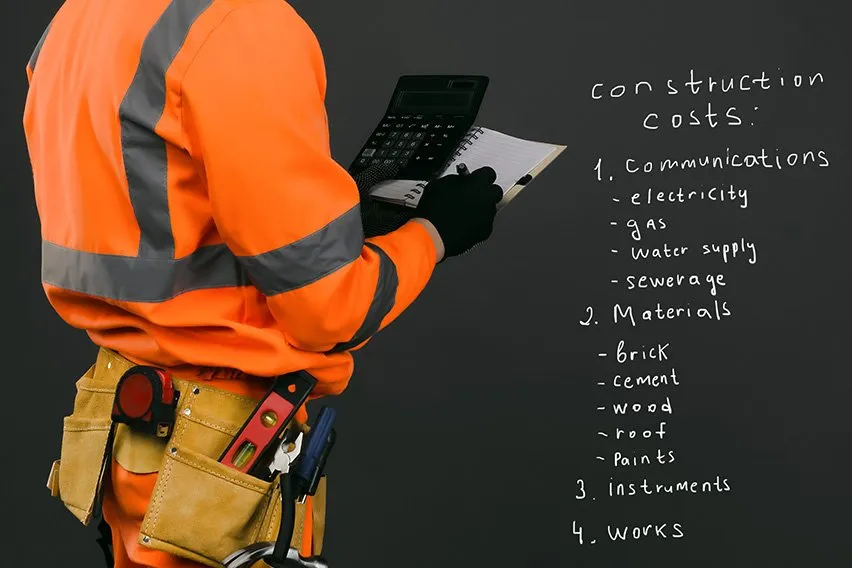10 Best Construction Estimating Software in 2025 (Free & Paid)

Creating great estimates is an essential part of the construction process—it helps you win bids, create budgets, and maintain strong customer relationships. Construction estimating software is the best way to create efficient and accurate bids for any type of construction project.
There’s a wide array of contractor estimating software available, from straightforward takeoff tools to comprehensive systems for budgeting and project management. Choosing the right construction cost estimating software depends on the tools your business needs, as well as the size and budget of your company.
We’ll explore ten construction estimating software options, and tips for choosing the right construction software so you can find the best fit for your small business.
Key Takeaways
- Construction estimating software helps improve efficiency and accuracy.
- Good estimating software offers takeoff tools, integrations, and an easy user interface.
- Consider your business’s size, budget, and needs when choosing software.
- Cloud-based estimating software makes it easy to create estimates on the job site.
Table of Contents
- FreshBooks
- STACK
- ProEST
- Esticom
- Builder Trend
- Contractor Foreman
- Projul
- Clear Estimates
- Sage Estimating
- SimPRO
- What Is Construction Estimating Software?
- Construction Estimating Software for Commercial and Residential Projects
- Advantages of Using Construction Estimating Software
- How to Choose the Best Construction Estimating Software as per Your Business Needs
- Tips for Using Construction Cost Estimating Software
- Why Do Cloud-Based Solutions Matter in Contractor Estimate Software?
- Conclusion
- Frequently Asked Questions
Fortunately, construction estimation software is now widely accessible. Most specialized construction estimating solutions are generally affordable, with some options even being free to use up to a certain amount or offering a free trial for a certain period to help mitigate the construction estimating software cost. Other choices offer custom pricing for businesses that have unique needs. Of course, this leads to the challenge of choosing the best construction estimating software.
If you run a construction business and aren’t sure which construction estimating software program is right for you, we’ve narrowed the list to 10 choices that provide advanced features for generating professional proposals and estimates.

1. FreshBooks
FreshBooks offers a robust and efficient way to manage all your construction estimates and invoicing. A wide variety of construction estimate templates lets you easily fill in relevant fields for materials and labor so you can share accurate estimates with your customers. Convert estimates into invoices at the click of a button for effortless billing.
In addition to FreshBooks estimating software, you’ll also have access to versatile accounting software that makes it easy to track your income, manage your budget, and file all your necessary details for a stress-free tax season.
Features
- Access invoice templates and create custom invoices
- Easily convert estimates to invoices
- Personalize invoices with branding, logos, and individual discounts
- Respond to client feedback on estimates
- Organize and track estimates and invoices
Pricing
- Free 30-day trial
- Lite: $21.00/month
- Plus: $38.00/month
- Premium: $65.00/month
- Custom plans available upon request
2. STACK
STACK offers a comprehensive array of tools for detailed construction estimates. The in-depth measuring tools make it easy to calculate a variety of metrics like area and volume, while the materials calculation system helps you assess the cost of the job. The cloud-based system makes it easy to share estimates with your clients.
STACK integrates well with other construction tools, but is somewhat limited in broader integrations. This may be a drawback for small business owners looking for an estimates tool that’s compatible with their existing accounting and other software.
Features
- Calculate the materials needed to complete construction
- Cloud-based system for sharing estimates and invoices
- Versatile tools for area, arc, volume, and other measurements
- Library of takeoff templates
Drawbacks
- Limited integration with other software
- Some minor delays reported with loading
Pricing
- Takeoff and estimating software for $1,899/year
3. ProEST
ProEST is geared towards project management, making it a helpful tool for larger construction companies, looking to streamline their management process. The bid management tools make it easy to invite contractors to bid, while the bid analysis gives a comprehensive overview of bids.
Some challenges arise with the user interface—the number of tools and the organization can make it a difficult learning curve for many users. The cloud-based system adds to the collaborative aspect, but it means that the software cannot be accessed for offline use.
Features
- Cloud-based system for easy collaboration
- Robust bid invitations and bid management system
- Includes on-screen digital takeoffs
- Integrates with popular software like AutoDesk Build and Sage Intacct
Drawbacks
- No offline access
- The interface presents a learning curve for many users
Pricing
- Pricing available upon request
4. Esticom
Esticom is a versatile takeoff and estimating software that offers a wide array of tools for measuring and estimating the cost of a construction job. In addition to standard takeoff tools, it includes project templates to easily organize job details, and a deadline tracker to help all team members stay on track.
Since Esticom is geared mainly at generating estimates, it’s limited in its ability to create quotes and share information with clients. It offers unlimited users and data with the annual plan, but users have to contact a sales representative to see annual plan prices.
Features
- Cloud-based construction software
- Includes project templates
- Project deadline tracker for staying on time
- Export proposals in Word and PDF
- Unlimited users and data
Drawbacks
- Minimal ability to customize quotes
- Difficult to integrate updated vendor prices
Pricing
- Free trial available
- Pricing by request
5. Builder Trend
Builder Trend is a strong option for users looking for comprehensive estimating software with a construction industry focus. The scheduling tools and integrated payment processor, as well as its integration with other software like QuickBooks and Xero, make it easy to use one central system for all your planning and organizing.
All those features come with a price tag, and Builder Trend is among the more expensive estimating software options. It also presents a learning curve that can be difficult when onboarding collaborators and vendors.
Features
- Includes a straightforward scheduling feature
- Integrated payment processing system
- Integrates with QuickBooks and Xero
- Templates for proposals
Drawbacks
- Interface can present a learning curve
- Long set-up process
Pricing
- Essential: $499/month
- Advanced: $799/month
- Complete: $1,099/month
6. Contractor Foreman
Contractor Foreman offers a comprehensive tool for construction estimating and project management. It’s especially strong on the management side, with a wide array of tools for scheduling projects, tracking progress, and sharing invoices.
The tiered plan system makes it more affordable than many competitors, but it can also present challenges. If a solo user wants to access more advanced features, they’ll have to purchase a more expensive plan instead of adding individual features.
Features
- All plans come with financial module options
- Group and private software training
- Includes scheduling and project management tools
- Features for invoicing, payments, and expenses
Drawbacks
- Can’t be used offline
- Limited number of users per plan
Pricing
- 30-day free trial
- Basic: $49/month
- Standard: $79/month
- Plus: $125/month
- Pro: $166/month
- Unlimited: $249/month
7. Projul
Projul is known for its approachable user interface and versatile management system. Users can generate estimates from easy-to-use templates and copy those estimates to share easily with clients and other team members. A variety of project management views makes it easy to coordinate scheduling.
Projul is designed for smaller companies and offers three pricing plan tiers for up to 10, up to 20, and 20+ employees. However, these prices may be a barrier for single users looking for a basic and affordable option.
Features
- Explore custom estimate templates
- Integrated payment processing
- Multiple project management views
- Includes a mobile app for added convenience
Drawbacks
- Can get expensive for small businesses
Pricing
- Starter: $4,788/year
- Pro: $8,388/year
- Enterprise: $14,388/year
8. Clear Estimates
Clear Estimates focuses on the basics with software designed primarily for estimating. The system regularly updates the prices of materials to streamline the estimating process and offers a selection of templates that can be quickly and easily filled out.
The per-user pricing system is an affordable option for solo users and small businesses but can add up quickly for larger companies with many users.
Features
- Wide array of preloaded templates
- Allows you to create payable invoices
- Integrates with other software like Builder Trend and QuickBooks
- Regular materials pricing updates
Drawbacks
- Doesn’t offer a mobile option
- Per-user billing can become costly
Pricing
- Standard: $79/month
- Pro: $119/month
- Franchise: $249/month depending upon customization
9. Sage Estimating
Sage Estimating is designed to help users create clean and accurate estimates and bids. The takeoff tools and an extensive cost database along with cost forecasts enable users to generate highly accurate estimates. The tracking and reporting tools help measure overall costs and success.
The detailed interface can be difficult for new users, with fewer visual tools presenting a harder shift from pencil-and-paper measuring. Additional time for linking takeoff and spreadsheets may also slow down workflow.
Features
- Integrated electronic takeoff tools
- Forecasts for labor, material, and overhead costs
- Pull 2D and 3D details
- Tracking and reporting tools for work overviews
Drawbacks
- Interface can present a learning curve
- Linking processes can be time-consuming
Pricing
- Pricing by request
10. SimPRO
SimPRO is a great fit for users who want to create estimates on the go. The mobile app makes it easy to organize data and generate estimates on the job site, helping to boost conversion and win bids. It also integrates well with popular software like Ground Plan and Xero so all aspects of your business can fit together.
Features
- Integrates with other construction and financial software like Ground Plan and Xero
- Tracks job costs
- User-friendly interface
- Cloud-based software
- Includes mobile app
Drawbacks
- Time-consuming setup process
Pricing
- Pricing by request
What Is Construction Estimating Software?
Construction estimating software is an application that automates the estimation process so that contractors and construction businesses can deliver quick and accurate estimates to customers.
Traditional estimation processes require a lot of manual measurements, calculations, and cost assessments. Construction estimating software streamlines this process for general contractors and construction companies by providing digital measurement tools, automated calculations, and databases with cost information.
Robust construction estimating software helps users create a more efficient estimating process, and may also include additional features for sharing estimates, tracking bids, and receiving payments. It’s helpful to have software that integrates with your other systems so you can keep track of jobs and expenses and generate comprehensive financial reports.
Construction Estimating Software for Commercial and Residential Projects
Construction estimating software helps you save time and money on any type of construction project. Explore different features for residential and commercial projects to help you find the best construction estimating software for your small business.
Estimating Software for Residential Projects
Streamline your residential construction estimating process with tools that support you and your customers. Explore features including:
- Pre-Built Templates: Save time on estimates with ready-made templates for common residential projects. Explore fillable templates for kitchens, bathrooms, additions, and more, with options for renovations and new builds.
- Design Software Integration: Simplify your design-to-estimates process with easy software integrations. Look for construction estimating software that integrates with design software so you can estimate prices for any design modifications.
- Materials Cost Databases: Get the most up-to-date information on construction prices with estimating software that includes a regularly updated database of common materials costs.
Estimating Software for Commercial Projects
Make commercial project estimation a breeze with estimating software designed for large projects and complex builds. Browse features like:
- Material Cost Calculators: Manage high-volume materials costs with advanced calculation tools. Quickly adjust for changes in materials prices and calculate complex builds with accuracy.
- Large Project Labor Calculations: Commercial estimating software makes it easy to calculate labor costs for projects that require large crews and specific timelines. Include costs for overtime and other labor adjustments.
- Project Management Integrations: Simplify your scheduling process with construction estimating software that integrates with project management software. Connect labor schedules, sync with clients, and provide up-to-date information on new estimates and additions.
- Subcontractor Tools: When your commercial construction projects require bringing on subcontractors, the right construction estimating software helps you manage subcontractor bids and integrate them into your overall estimate.
Advantages of Using Construction Estimating Software
While some small businesses might hold fast to traditional methods, there are noteworthy advantages to using commercial construction estimating software as an estimating tool instead. In a construction company, the benefits can make a big difference in winning new contracts and putting together accurate estimates more easily—provided you choose the best construction estimating software for your needs.
Construction estimating software can eliminate spreadsheet errors
Even though spreadsheets offer some level of automation (with formulas and pre-loaded calculations), it’s always possible to miss a step when editing the spreadsheet for a new client. Software tools for construction estimating rarely make this same error, so you can create accurate estimates.Construction estimating software programs communicate professionalism
In a modern age of tech, clients expect digital processes and cloud-based estimate solutions, especially when it comes to something as important as construction management. Many estimating software programs have the ability to send information directly to clients, smoothing out the estimating process even more.The top construction estimating software boosts productivity and is a huge time-saver
While a business might still assign the work of project estimates to a particular staff member, the actual estimating process rarely requires as much energy as the traditional method. Because of this, an employee can devote time to more important tasks. It also means that future clients receive estimates in a more timely fashion.Construction software may influence client acquisition
Clients may be more likely to sign on when a project bid looks professional, accurate, and detailed. This benefit can also improve the chances of concurrent projects per client.
How to Choose the Best Construction Estimating Software as per Your Business Needs
Before settling on any of the above software choices, make sure that you have a reliable understanding of your business and its unique needs regarding project management and choosing the best construction estimating and software solution. Being realistic will ensure that your choice is based on honest facts and that the solution fulfills its intended purpose.
When choosing your top construction estimating software, set aside time to answer the following questions.
- What are your current pain points? Maybe your estimating process isn’t entirely broken, but communicating with clients could be upgraded. Pinpoint where the current frustrations are, and choose software that will meet those needs.
- What collaboration tools are critical for your process? The estimating process might be one person’s job, but it’s highly unlikely that only one individual is involved. Choose software that promotes cross-departmental collaboration and administrative oversight where it’s needed.
- What is the monthly cost? Construction estimation tools are highly beneficial, but you don’t need to overpay for key features unless you really need them.
Another important feature to consider is whether the tool offers a mobile app, as it provides greater flexibility and boosts productivity for professionals who are often on-site. Our article on the construction cost estimator apps will help you find the right app.
Tips for Using Construction Cost Estimating Software
Providing timely, clear, and accurate construction cost estimates for potential projects is only one part of the puzzle. When using estimation and bidding software, keep the following tips in mind.
Verify Cost Estimating Prior To Sending Any Contract
A good program will do the heavy lifting for you, but don’t forget to preview the document before sending it. You could leave good work on the table when you submit an incorrect estimate.Shop Around
With so many options for project management tools and electrical estimating software, it’s essential to do your due diligence.Provide Thorough Training And Education
Choosing from software companies that provide user-friendly options eliminates some of the learning curve. Good training, however, is still important. You want training that includes resources for employees on how to implement the new solution, plus training on how to estimate small business projects in general.Encourage Company-Wide Adoption And Understanding
Before adopting any technical solution, ensure that the broader team knows and understands each new process. Doing this makes it easier for employees to ask for help and direct each other to valuable resources.
Why Do Cloud-Based Solutions Matter in Contractor Estimate Software?
If your business depends on writing detailed cost estimates, ensure that you understand each software option’s flexibility and security. Cloud-based solutions are ideal since they allow for estimate creation, whether sitting at your desk or out in the field on a job site. This convenience ensures that your business never misses an opportunity to deliver accurate construction estimates and other information to a potential client.
Cloud-based data is also encrypted, meaning that it benefits from top-level security features and protection. While you enjoy real-time access to your estimating programs, clients enjoy the peace of mind of knowing their information is safe and secure.

Conclusion
Construction estimating software is a great way to streamline your estimating process and save time and money. Measurement and calculation tools help increase the accuracy of your estimates while scheduling and tracking tools make it easy to organize any job.
There is a wide array of construction estimating software on the market, from quantity takeoff tools to comprehensive project management tools. Choosing the right software depends on the size of your company, your existing software, and which features you need to boost your estimating efficiency.
FAQs About Construction Estimating Software
Do you have more questions on the ins and outs of construction accounting, project management, or choosing construction estimating software? Here are some frequently asked questions—answered.
What is estimating in construction?
Construction estimating is calculating all the costs of a construction job, including labor, materials, and overhead. Construction estimating software helps automate this process to minimize the time spent on calculations and improve the workflow of construction projects.
What are the 4 types of estimates in construction?
The four main types of estimating are: Preliminary estimates (used as rough, approximate estimates), detailed estimates (a more fleshed-out, informed, and accurate estimate), quantity estimates (used purely to determine the number of materials needed for a project), and bid estimates (a holistic estimate used to secure a contract for a potential project).
Reviewed by
Kristen Slavin is a CPA with 16 years of experience, specializing in accounting, bookkeeping, and tax services for small businesses. A member of the CPA Association of BC, she also holds a Master’s Degree in Business Administration from Simon Fraser University. In her spare time, Kristen enjoys camping, hiking, and road tripping with her husband and two children. In 2022 Kristen founded K10 Accounting. The firm offers bookkeeping and accounting services for business and personal needs, as well as ERP consulting and audit assistance.
RELATED ARTICLES



 Building Cost Estimator: Calculating Construction Cost
Building Cost Estimator: Calculating Construction Cost How to Estimate Construction Jobs: 10 Steps
How to Estimate Construction Jobs: 10 Steps  How to Charge for Catering: A Complete Pricing Guide
How to Charge for Catering: A Complete Pricing Guide How Much to Charge for Delivery? A Small Business Owner’s Guide
How Much to Charge for Delivery? A Small Business Owner’s Guide Is an Estimate Legally Binding? | A Small Business Primer
Is an Estimate Legally Binding? | A Small Business Primer